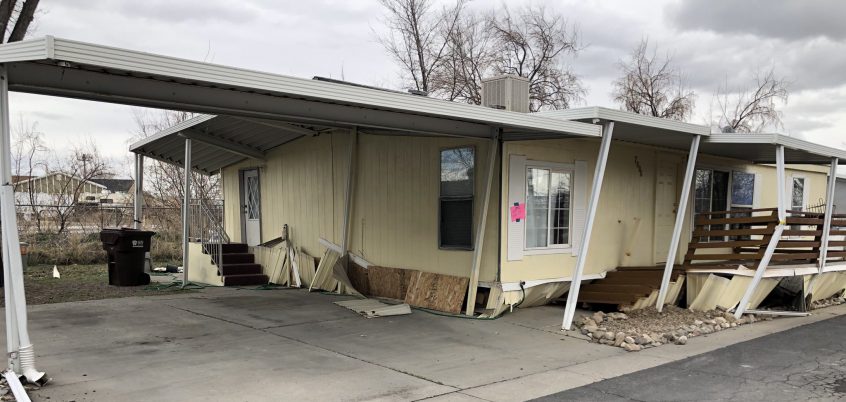Manufactured homes, often called mobile homes or trailers, have been popular housing choices for decades. Many people opt for these homes due to their affordability, flexibility, and quick installation. However, older manufactured homes may have outdated features, poor insulation, and inefficiencies that can impact comfort and energy costs. Retrofitting or upgrading these homes with modern improvements can bring many benefits, ranging from increased energy efficiency to enhanced comfort and safety. This article will explore the advantages of retrofitting an older manufactured home and how it can positively impact homeowners.

Understanding Retrofitting
Retrofitting involves improving or upgrading an existing structure to enhance its performance, efficiency, and functionality. In older manufactured homes, retrofitting typically addresses insulation, energy efficiency, structural integrity, and overall comfort issues.
Benefits of Retrofitting an Older Manufactured Home
1. Improved Energy Efficiency
One of the primary benefits of retrofitting an older manufactured home is improved energy efficiency. Older homes often need more insulation and have outdated heating and cooling systems, leading to higher energy bills. Retrofitting can include adding insulation to walls, floors, and ceilings, installing energy-efficient windows and doors, and upgrading heating, ventilation, and air conditioning (HVAC) systems. These improvements can significantly reduce energy consumption and lower utility costs over time.
2. Enhanced Comfort
Retrofitting can also enhance comfort levels within the home. Homeowners can maintain more consistent indoor temperatures year-round by addressing insulation deficiencies and sealing air leaks. Additionally, upgrading HVAC systems can provide better airflow and more precise temperature control, creating a more comfortable living environment for residents.
3. Increased Property Value
Retrofitting an older manufactured home can increase its property value. Energy-efficient upgrades and modern amenities appeal to homebuyers and can make the home more attractive on the real estate market. Additionally, retrofitting can address structural issues or code violations, enhancing the home’s value and desirability.
4. Extended Lifespan
By retrofitting an older manufactured home, homeowners can extend its lifespan and reduce the need for costly repairs in the future. Upgrading structural components, such as roofing, siding, and foundation systems, can enhance durability and resilience against weather-related damage. Modernizing plumbing, electrical, and HVAC systems can prevent potential issues and ensure the home remains functional for years.
5. Health and Safety Benefits
Retrofitting can also improve the health and safety of occupants. Upgrading to energy-efficient windows and doors can enhance indoor air quality by reducing drafts and preventing moisture buildup, which can lead to mold and mildew growth. Additionally, retrofitting can include installing carbon monoxide detectors, smoke alarms, and other safety features to protect against potential hazards.
6. Environmental Impact
Retrofitting older manufactured homes to improve energy efficiency can have a positive environmental impact. By reducing energy consumption, homeowners can lower their carbon footprint and contribute to environmental conservation efforts. Additionally, using sustainable building materials and practices during retrofitting further minimizes the home’s environmental impact.
Retrofitting Options
There are several retrofitting options available for older manufactured homes, depending on the specific needs and budget of the homeowner:
- Insulation Upgrades: Insulation to walls, floors, and ceilings can improve thermal performance and energy efficiency.
- Window and Door Replacement: Upgrading to energy-efficient windows and doors can enhance insulation and reduce air leaks.
- HVAC System Upgrades: Installing a high-efficiency HVAC system can improve comfort and reduce energy consumption.
- Roofing and Siding Replacement: Upgrading roofing and siding materials can improve durability and weather resistance.
- Plumbing and Electrical Upgrades: Updating plumbing and electrical systems can ensure safety and functionality.
- Energy-Efficient Appliances: Installing energy-efficient appliances can reduce energy consumption and utility costs.
- Solar Panel Installation: Adding solar panels can provide renewable energy and reduce utility bills.
Conclusion
Retrofitting an older manufactured home offers many benefits for homeowners, ranging from improved energy efficiency and comfort to increased property value and environmental sustainability. By investing in upgrades and improvements, homeowners can enhance their homes’ performance, longevity, and overall quality while enjoying lower utility costs and a more comfortable living environment. Whether addressing insulation deficiencies, upgrading HVAC systems, or installing energy-efficient appliances, retrofitting is a cost-effective way to modernize older manufactured homes and unlock their full potential.
See Also:
- Keeping Warm: Essential Mobile Home Heating Maintenance Tips
- Do I Need Insurance for My Mobile Home?
- 10 Best Neighborhoods to Buy a Mobile Home in Florida
- 10 Essential Items Every Mobile Home Needs for Comfort and Functionality
- What to Expect from a Mobile Home Under $15,000

